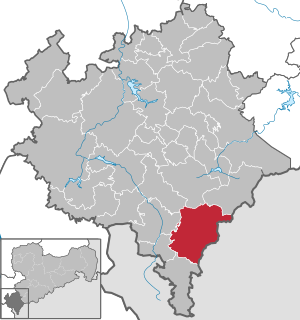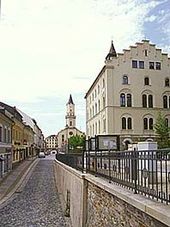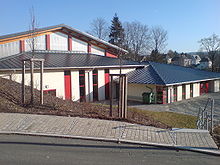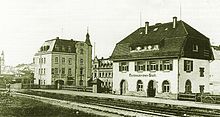Markneukirchen
| coat of arms | Germany map | |
|---|---|---|

|
Coordinates: 50 ° 19 ′ N , 12 ° 19 ′ E |
|
| Basic data | ||
| State : | Saxony | |
| County : | Vogtland district | |
| Height : | 504 m above sea level NHN | |
| Area : | 69.06 km 2 | |
| Residents: | 7470 (Dec. 31, 2019) | |
| Population density : | 108 inhabitants per km 2 | |
| Postal code : | 08258 | |
| Area code : | 037422 | |
| License plate : | V, AE, OVL, PL, RC | |
| Community key : | 14 5 23 200 | |
| City structure: | 14 districts | |
City administration address : |
Am Rathaus 2 08258 Markneukirchen |
|
| Website : | ||
| Mayor : | Andreas Rubner (independent) | |
| Location of the town of Markneukirchen in the Vogtlandkreis | ||
Markneukirchen is a town in the Saxon Vogtlandkreis . It is located in the Elster Mountains between the Ore Mountains and the Fichtel Mountains and is one of the main locations in the Musikwinkel .
geography
Geographical location
Markneukirchen is one of the southernmost Saxon cities in the upper Vogtland . On both sides of the Schwarzbach , a right tributary of the White Elster and its side valleys, the city and its associated corridor spread over the northern and southern mountain ridges. To the south of the city are the districts of Schönlind, Landwüst and Wernitzgrün above and away from the Schwarzbachtal. The entire urban area is drained by tributaries of the Elster. It lies at an altitude of between 468 m in the Siebenbrunn district and 803 m on the Hohen Brand .
Neighboring communities
Markneukirchen borders on six municipalities and the Czech Republic in the southeast . In particular, these are Bad Brambach , Bad Elster , Adorf / Vogtl. , Mühlental , Schöneck / Vogtl. and Klingenthal .
City structure
The following districts belong to the city of Markneukirchen:
- Breitenfeld with Bernitz green
- Erlbach with Kegel and Hetzschen
- Eubabrunn
- Gopplas green
- State municipality
- Rural desert
- Schönlind
- Siebenbrunn with Sträßel
- Wernitzgrün
- Wohlhausen with Friebus
climate
The climate of the area is cool according to the altitude. The mean annual temperature is 6 °, the amount of precipitation around 700 mm.
history

The settler village of Nothaft , founded in the 13th century, was initially named after a knightly family from Egerland - Albertus Nothaft de Wildstein (see also the Notthracht family ) led Bavarian / Upper Palatinate settlers to this area as a locator . This name was also mentioned in a document from 1378 ( Nuwenkirchen dictum Nothaft ). The place name Neukirchen first appeared around 1274, going back to the founding of a church, in a document from the Waldsassen monastery in which a Chunradus de Newenkirchen was mentioned, probably the owner of the local knight's seat .
In 1357 ( Nuenkirchin ) and 1360 ( stat ) the place appeared as a market with the same rights as the probably older neighboring towns of Adorf and Oelsnitz . The founders of the market were the bailiffs of Plauen (probably Heinrich the Elder or Heinrich the Long), who wanted to consolidate their power against the Wettins through a planned urban policy . Towards the end of the Thirty Years War , in the course of the Counter Reformation, Bohemian exiles moved to Markneukirchen for reasons of faith. Among them were 12 violin makers from Graslitz . In 1677 these masters united to form Germany's first violin making guild. This started the tradition of making musical instruments in Markneukirchen. Until then only violins were made, but workshops for all types of orchestral instruments followed after 1700. A string makers guild was founded in 1777, and in 1797 the French horn and pipe makers merged to form the Musical Instrument Makers Society. The importance of Markneukirchen as the center of the Vogtland musical instrument industry with far-reaching export relations is underlined by the fact that the USA maintained a consular agency here from 1893 to 1916 . In the first half of the 19th century, the Markneukirchen plucked instrument building established itself. Around 1900 around 50 percent of the world's instrument and component production came from Markneukirchen and the surrounding area. There is no verifiable evidence for a share of 80%, of which one can read from time to time.
On the night of April 22nd to 23rd, 1840, 171 residential houses, 140 barns and 258 side and back buildings fell victim to a terrible fire along with the public buildings. More than half of the city - especially the oldest part - was destroyed. The reconstruction was carried out very quickly and changed the appearance of the place permanently. The city was rebuilt generously, but often more soberly, but now offered sufficient space for the population and industry to grow.
The current spelling of the place goes back to the year 1858, in which the common name Markt Neukirchen was changed to Markneukirchen by a royal decision from Dresden , omitting the t in the place name , in order to prevent confusion with other Neukirchen. Until 1856, Markneukirchen belonged to the Electoral Saxon or Royal Saxon Office of Voigtsberg , after 1856 to the Markneukirchen court office and from 1875 to the Oelsnitz administration (from 1939 "Oelsnitz district").
As part of the district reform of 1952 , the city came together with seven other communities to the district of Klingenthal within the district of Karl-Marx-Stadt . After reunification, Markneukirchen initially continued to belong to the Klingenthal district within the Free State of Saxony. Since the late implementation of the first Saxon district reform in the Vogtland in 1996, the city has belonged to the Vogtlandkreis .
Incorporations
| Former parish | date | annotation |
|---|---|---|
| Amber green | before 1875 | Incorporation to Breitenfeld |
| Breitenfeld | 03/01/1994 | |
| Erlbach (with Hetzschen and Kegel ) | 01/01/2014 | |
| Eubabrunn | 06/01/1936 | Incorporation to Erlbach |
| Gopplas green | 06/01/1936 | Incorporation to Erlbach |
| State municipality | 01/01/1908 | Reclassification of the district from Zwota to Erlbach |
| Rural desert | 01/01/1999 | |
| Schönlind | 07/01/1950 | |
| Siebenbrunn (with Sträßel) | 07/01/1950 | |
| Wernitzgrün | 01/01/1999 | Incorporation to Erlbach |
| Wohlhausen (with Friebus ) | 01/01/1994 |
Population development
Development of the population:
|
|
|
politics
City council
Since the municipal council election on May 26, 2019 , the 18 seats of the city council have been distributed among the individual groups as follows:
mayor
Andreas Rubner (since July 2015), non-party . The predecessor in office was Andreas Jacob (CDU).
coat of arms
The founding of the bailiffs is also shown in the city coat of arms. Similar to the coats of arms of Plauen and Adorf , it shows the coat of arms of the Plauen bailiffs: a golden lion raised to the right with a double tail and a flapping tongue.
Town twinning
- Heusweiler in Saarland
Culture and sights
Museums
- The Markneukirchen Musical Instrument Museum was founded in 1883 by the teacher and organist Paul Otto Apian-Bennewitz . During this time, orchestral instrument making flourished in the Musikwinkel through trade with many European countries and the USA. The founder of the museum intended to create a training facility for local instrument makers and to record musical instruments from all over the world. The collection holds over 6,500 exhibits from Europe, Asia, Africa, America and Australia, but the focus is on domestic production. Numerous unique items and curiosities enliven the collection, which is unique in its kind due to the representation of instrument making from the 17th century to the present day. Over 3 million people have visited the museum in the past 60 years.
- The Framus Museum , which opened in July 2007, pays tribute to a success story of the German economy after the Second World War. In the 1950s and 1960s, the Framus brand , based in Bubenreuth, Franconia , gained worldwide renown until the company went bankrupt at the end of the 1970s. Musicians such as Attila Zoller , Volker Kriegel , Bill Lawrence , Jan Akkerman , Bill Wyman from the Rolling Stones and John Lennon from the Beatles played on guitars and basses from this German musical instrument manufacturer. In a renovated and converted Wilhelminian style villa, 200 instruments from what was once Europe's largest guitar factory are presented on three floors. The museum is currently (as of August 2020) closed.
- In the musical instrument making demonstration workshops of the music school, traditional techniques of building string and brass instruments are demonstrated.
- A large number of mechanical jukeboxes shows Hüttels Musikwerk exhibition in the Wohlhausen district. You can see orchestrions , carousel organs, flute clocks , gramophones and much more.
- In the district Landwüst is the Vogtländische outdoor museum Landwüst . There the way of working and living of the rural population in the Upper Vogtland is presented. Several buildings can be visited, some of which were built before 1800.
- In the district Eubabrunn is the Vogtländische outdoor museum Eubabrunn .
music
Every year young musicians come to the center of German orchestral instrument making thanks to the international instrumental competitions ( Musiktage ) that take place in Markneukirchen . By resolution of the city council of Markneukirchen on December 12, 2002, the studied orchestral musician, music teacher, long-time director of the Markneukirchen music school and conductor of the symphony orchestra Wolfgang Wolfert "due to his decades of meritorious work as a music teacher and conductor of the city symphony orchestra" became on March 15, 2003 City Music Director appointed. He succeeds the music teacher, composer and arranger Albrecht Herrmann, who was given this honor as the first conductor after 1990. In March 2017, the Markneukirchen high school teacher, musicologist and orchestra conductor Enrico Weller was appointed as the new town music director. Thus, for the first time in the history of Markneukirchen, there are two personalities who carry this title at the same time.
Buildings
- The neo-Romanesque Evangelical Lutheran St. Nicolai Church is located in the center of the city on the market. Construction began in 1842 according to plans by Ernst Hermann Arndt , a student of Gottfried Semper . The church was consecrated in 1848. In the course of the redesign of the inner city and the market square after the great city fire of 1840, the east facing of the church was dispensed with. The 56 meter high church tower with the main entrance faces east, towards the market square, the altar is on the opposite west side. The church houses the largest, almost completely preserved Schulze organ in Germany and the only one in Saxony. Concerts take place there regularly.
- The old district court is also on the market opposite the church . The foundation stone for the neo-Romanesque building, which was initially designed as a new town hall after the town fire, was laid in 1843. As early as 1852, the Kingdom of Saxony acquired it for use as a district court . Today the building is used as a medical center by 3 general practitioners, a pediatrician, a physiotherapy practice and a pharmacy.
- One of Saxony's Bismarck towers is located on the Upper Mountain in Markneukirchen . It was built in 1900 according to the Götterdämmerung design by the Dresden architect Wilhelm Kreis and is used as a lookout tower. The ascent to the glazed viewing platform of the 14 meter high tower takes place on 58 steps.
- The so-called Paulus-Schlösschen am Bienengarten is a late Baroque residential building that survived the great city fire in 1840. It has housed the Markneukirchen Musical Instrument Museum since 1942 .
- The Villa Merz in Adorfer Strasse was built in 1900–1903 in Art Nouveau style by the manufacturer Curt Merz. Today it is the seat of the musical instrument making course at the West Saxon University of Applied Sciences Zwickau (FH), Department of Applied Arts Schneeberg .
- The Framus Museum is located in the Villa Brehmer, built in 1898 .
- The Villa Stark, built in 1896, is modeled on a Breton castle . It houses a children's home.
Sports
Markneukirchen has two soccer fields, two sports halls, one of which was only completed in 2007, and an outdoor pool (which was renovated in summer 2013) with a 10-meter diving platform.
Sports can be played in several clubs:
- Wrestling club AV Germania eV , currently fights in the 2nd Bundesliga North of the German Wrestling Association. In the 2009/10 season , the then AV Germania 06 was in the Ringer Bundesliga , where it took fifth place in the East relay
- Football club SC Markneukirchen
- Popular sports club SG Neptun Markneukirchen (acrobatics, handball, bowling, volleyball, general sports group)
- Judo Club
- Tennis club
- Recreational sports club
- Chess club SV Markneukirchen
- Ju-Jutsu Team Markneukirchen
Economy and Infrastructure
traffic
Markneukirchen is located on the federal road 283 from Adorf / Vogtl. leads via Klingenthal into the Ore Mountains to Aue .
After the railway stations in Markneukirchen (1975) and Siebenbrunn (2012) were closed, the closest railway station is Adorf / Vogtland, just under six kilometers away. From Adorf to Markneukirchen there is a bus connection tailored to the trains.
As early as the 1850s there were plans for a rail link that would also open up Markneukirchen. The Voigtland State Railroad, Herlasgrün – Falkenstein – Ölsnitz – Eger, opened in 1865 , but ultimately led far past Markneukirchen. Even when the Chemnitz – Adorf railway line was built by the Chemnitz-Aue-Adorfer Eisenbahn-Gesellschaft , Markneukirchen did not have a station in the city. Since the city contributed financially to the construction of the railway, the nearby train station on Siebenbrunner Flur was given the name Markneukirchen . In 1909 the branch line Siebenbrunn – Markneukirchen was opened, at which Markneukirchen had its own train station in the city center and a stop near the post office. In 1911 this route was extended to neighboring Erlbach. The line was closed in 1975, the station in Siebenbrunn was served by the Vogtlandbahn until 2012 .
Established businesses
- Catgut GmbH, one of the oldest manufacturers of surgical sutures in Germany.
- Markneukirchen is known as the center of orchestral instrument making, many types of musical instruments are made in many small family businesses and some medium- sized businesses.
- Clarinets are manufactured by F. Arthur Uebel GmbH .
- Brass instruments and mouthpieces of all kinds have been made by Werner Chr. Schmidt for more than 170 years.
- W. Schreiber & Söhne GmbH and B&S GmbH , which were taken over by the French company Buffet Crampon in 2010 and 2012 , respectively, manufacture wind instruments .
- Markneukirchen is the seat of Warwick GmbH & Co Music Equipment KG . The company manufactures electric basses , Framus brand electric guitars and amplifiers .
- The Mönnig brothers - Oscar Adler & Co. Holzblasinstrumentenbau GmbH Markneukirchen are based in Markneukirchen.
- Mechanics are manufactured in Thomas Rubner GmbH Markneukirchen.
- The Markneukirchen embossing plant ( VEB Präwema ) produced most of the GDR's medals and badges until 1990 . Today, badges and similar advertising media are manufactured here under the name Praegewerk Markneukirchen GmbH .
- The automotive supplier Automotive Interior World operates a factory for the production of interior components.
- In the GDR, plucked instruments in particular were mass-produced under the Musima brand .
- Rohema , oldest baton manufacturer in the world
broadcast
Radio station Markneukirchen . During the GDR era, there was a medium-wave transmitter that was broadcast on 1089 kHz and 1341 kHz with 1 kW ERP each.
education
- In the Villa Merz can course musical instruments Markneukirchen the Zwickau University (FH) (School of Applied Arts Schneeberg) be visited.
- The municipal high school Markneukirchen with a music-artistic and mathematical-scientific profile is known for cultural highlights, such as musicals, in the Upper Vogtland.
- Interested citizens, young people and especially children can gain musical qualifications at the Reinhold Glier Music School. Above all, this promotes young talent for the city's numerous ensembles, such as the city's symphony and wind orchestras, the Migma craftsmen's orchestra, the youth wind and symphony orchestra and numerous amateur ensembles.
- The special school center "Upper Vogtland" runs the school part for learning support and the school part for intellectual development in Markneukirchen.
- Heimatverein Markneukirchen eV, founded on February 24, 1991, publishes several print products, including the Neikirnger Heimatbote , which has been published since 1994 .
Personalities
literature
- Friedrich August Crasselt: Attempt of a chronicle of Markneukirchen in the K. Sächs. Voigtlande. Designed by Friedrich August Crasselt, dZ Diaconus there , Schneeberg 1821.
- Franz Wilhelm Rudolf Hellriegel: Chronicle of Markneukirchen , Zwickau 1913.
- Erich Wild : History of Markneukirchen. City and parish , Plauen 1925 (supplement to the 34th annual publication 1925 of the Association for Vogtland History and Archeology). ( Digitized version )
- Richard Steche : Markneukirchen. In: Descriptive representation of the older architectural and art monuments of the Kingdom of Saxony. 10th booklet: Oelsnitz official administration . CC Meinhold, Dresden 1888, p. 10.
Web links
- Website of the city of Markneukirchen
- Markneukirchen in the Digital Historical Directory of Saxony
- Literature about Markneukirchen in the Saxon Bibliography
Individual evidence
- ↑ Population of the Free State of Saxony by municipalities on December 31, 2019 ( help on this ).
- ↑ Werner Pöllmann , Enrico Weller: Insights into 650 years of urban development - Festschrift for the 650th anniversary of the city, Markneukirchen 2010
- ↑ Guitars from Markneukirchen. In: Guitar & Laute 6, 1984, issue 2, p. 44.
- ↑ ibid. P. 110
- ↑ Stephen Evans: The sweet sound of success. BBC News, March 17, 2013, accessed December 26, 2013 .
- ↑ a b c Erich Wild : History of Markneukirchen. City and parish, Plauen 1925 (supplement to the 34th annual publication 1925 of the Association for Vogtland History and Archeology).
- ^ Karlheinz Blaschke , Uwe Ulrich Jäschke : Kursächsischer Ämteratlas. Leipzig 2009, ISBN 978-3-937386-14-0 ; P. 74 f.
- ↑ The Oelsnitz District Administration in the municipal directory 1900
- ↑ Community and place directory for the Kingdom of Saxony, 1904, publisher: Statistical Bureau of the Royal Ministry of the Interior
- ↑ a b c d e State Statistical Office of the Free State of Saxony: Area changes
- ↑ a b Das Sachsenbuch, Kommunal-Verlag Sachsen KG, Dresden, 1943
- ↑ Statistical Yearbook for the Kingdom of Saxony 1909, Volume 37
- ↑ a b Municipalities 1994 and their changes since January 1, 1948 in the new federal states , Metzler-Poeschel publishing house, Stuttgart, 1995, ISBN 3-8246-0321-7 , publisher: Federal Statistical Office
- ↑ a b Lists of the municipalities incorporated since May 1945 and evidence of the breakdown of the independent manor districts and state forest districts, 1952, publisher: Ministry of the Interior of the State of Saxony
- ^ A b c d Albert Schiffner : Handbook of geography, statistics and topography of the Kingdom of Saxony . Volume 1. Leipzig 1839
- ↑ Results of the 2019 municipal council elections
- ↑ https://www.statistik.sachsen.de/wpr_alt/pkg_s10_bmlr.prc_erg_bm_a?p_bz_bzid=BM151&p_ebene=GE&p_ort=14523200
- ↑ Framus Vintage. Retrieved August 15, 2020 .
- ↑ Show workshops - the world of musical instruments. Retrieved August 15, 2020 .
- ^ "Lighthouse" in the district court | Vogtland-Anzeiger - Vogtland. Retrieved December 12, 2019 .
- ↑ On the building history compare the article by Enrico Weller (Markneukirchen): The Villa Merz and its deciphered building history ( digitized version ).
- ↑ http://www.moennig-adler.de/nav_f.htm
- ↑ Torsten Hampel: A lot going on. In: Der Tagesspiegel . June 15, 2013.
- ↑ Upper Vogtland Promotion Center: Start. Retrieved December 12, 2019 .
- ^ Heimatverein Markneukirchen eV (HVM) From the club's history . on www.heimatverein-markneukirchen.de
- ^ GVK: bibliographical evidence .













